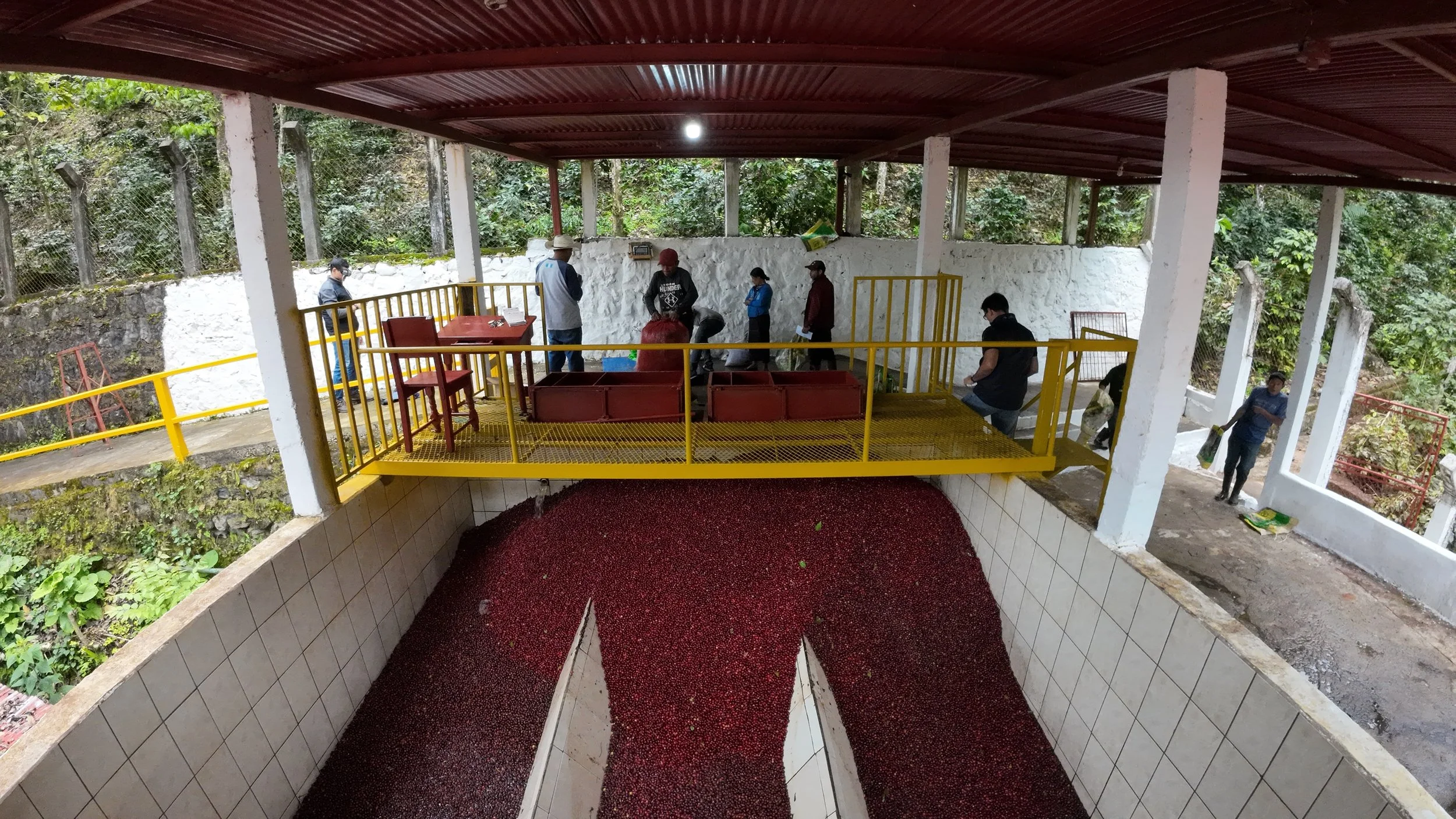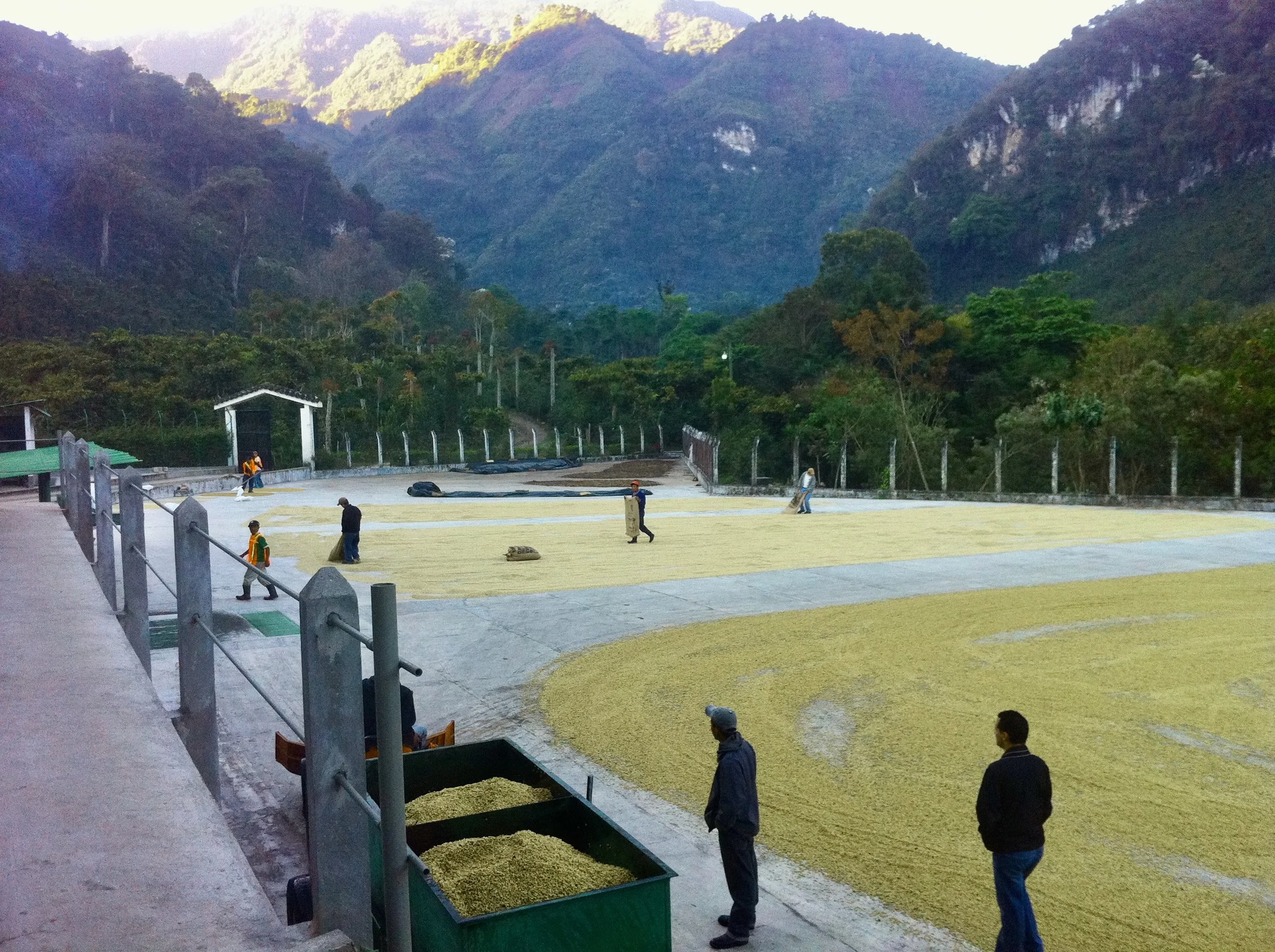What makes a Great Farm Great?
What makes a coffee farm a great coffee farm?
I didn’t know much about coffee when I took my first sourcing trip. Even though I had been in the coffee buisness for two or three years by that time, I had never been to a coffee farm and I only had general knowledge of coffee processing techniques.
When I found myself at a hand cranked mill in a remote section of Huila, Colombia, looking at coffee shrubs while surrounded by hard working harvesters in the act of bringing ripe coffee cherries to the depulper, it dawned on me that I knew absolutely nothing about how coffee was grown or processed. Literally everything I was seeing, feeling, smelling, and touching was a new learning experience. Parchment coffee? Huh? Fermentation? Why? There was so much to learn it was difficult to take it all in. EVERYTHING was a new experience so it was difficult for me to fully understand that EVERYTHING that was happening at the farm, every process, every action, would have a massive impact on the quality of the coffee I was going to buy.
While I had cupped 100s of different coffees by that point, I was not making the connection between what I was tasting in the cup with how a coffee grower’s actions and/or quality control, were affecting the coffee’s flavor. I did not have a clear understanding of how slightly underripe fruit, for example, could undermine a coffee’s potential or how over-fermentation could lead to funky overripe strawberry-like flavors in the cup.
I am still learning about coffee, in part because the coffee world continues to evolve. But the learning curve today is not as steep as it was 20 years ago. I used to spend at least 2-3 months a year sourcing coffee at origin. At first each trip was an overwhelming challenge but gradually I began to make the connections between what I was seeing on a farm with what I was tasting in that farm’s coffee. As I visited more farms in different countries and learned more about coffee harvesting and processing, I was building a bank of knowledge and with that knowledge-bank, a preference for certain types of farms, coffee varietals, and coffee-processing techniques.
As Bird Rock Coffee started to grow and gain a bit of a reputation for sourcing and roasting amazing coffee, it became increasingly important to buy from the world’s best farms — which is easier said than done. The problem is that most coffee farms are average. Like everything else, the bell-shaped curve applies; some horrible coffee farms exist, there are some truly great ones, there are fair farms and good ones but most, most coffee farms are average.
Like students in a classroom, you have some failures and some “A” students but the average grade for the typical class will be a “C”at the end of a school year, which is fine. Average coffee from average farms will easily find a home. But “Average” coffee is not what I needed to source for Bird Rock Coffee Roasters. I needed great coffee.
So how does one know when a farm is great or just average?
Sure, one can taste the difference in quality between farms but even the great farms will produce some average tasting lots and even an average farm can produce a great lot once in awhile. However, great coffee from average farms does not happen with the consistency a coffee roasting company needs from year-to-year. I have bought great coffee from what turned out to be average farms and the problem has always been the same: average farms cannot produce great coffee on a regular and predictable basis. There are many farms I have bought coffee from only once.
While the goal with sourcing at origin is to develop a long-term sustainable relationship with a grower, that relationship is absolutely founded on great coffee. And, while transparency and fairness are the foundation of any agreement a responsible coffee roaster has with a grower, there is no agreement without good coffee and no long-term relationship without great coffee year after year. Certainly, there will be seasons when environmental conditions negatively impact the quality of a great farm’s coffee. But great farms will be able to minimize the impact of events they cannot control while average farms don’t have the protocols in place to soften the blow of a bad season.
Over the years and countless farm visits, I began to see patterns of behavior that great farms seemed to share, regardless of what coffee-growing country they are in. In addition to incredible coffee, here are four traits that I look for when it comes to finding a great farm:
Cherry Selection and Training:
Deep Red Cherries at Finca La Bolsa, Guatemala
By the time I went to the famed Finca El Injerto in Guatemala, I had seen a good handful of farms. But nothing could have prepared me for what I was seeing at the El Injerto delivery station at the end of a harvest day during the peak of the season. At the time, El Injerto was one of the most famous farms in the world and was a perennial winner of Guatemala’s Cup of Excellence.
The coffee cherries I saw that day beautiful. Deep red perfectly ripe cherries were being dropped off by perhaps 75-100 different pickers. What seemed like a million pounds of cherries all one exact shade of red, not light red, not purple, but one single shade of brilliant cherry-red.
Quality starts with attention to cherry selection as there is a direct relationship between cherry selection and cup quality. Uniform cherry selection also promotes consistency over multiple lots of coffee that is harvested over several days/weeks during the season.
Attaining this level of quality control at El Injerto was no small feat considering that the farm stretches out over 100s of acres and employees 100s of seasonal employees. To pull it off takes a massive investment in training. All the pickers need to be on the same page as far as what to pick and what to leave on the shrub until the next pass through later in the season. In addition to training all the pickers, each group of pickers had a quality control lead who is helping to ensure quality in the field, long before the cherries are brought to the delivery station.
Cherry Delivery at El Injerto, Guatemala
For context, think of the training aspect like a coffee shop. The best coffee shops invest in training their baristas properly which takes a lot of time and a lot of money; not everyone can afford to do it or has the desire to do it, but a customer can certainly taste the difference and will continue to go where their experience is a positive one. The farms that recognize this crucial step and who are prepared to spend the time, energy, and money on training have a considerable leg up on the competition and, thus, can command a higher price for their product.
2. Employee Welfare is a Priority:
Investing not only in training but in employee well-being is another crucial piece of the quality puzzle. Every farm has year-around employees they need to retain and find ways to support. Additionally, a farm must hire numerous seasonal workers during the harvest season. The great farms who value these workers will see the same workers return year-after-year which in turn helps with training and certainly makes quality control easier.
Great farms will pay these workers more per day but the truly great farms offer additional benefits like cash bonuses, food, access to healthcare such mobile dentistry units on the farm during the harvest weeks.
Sadly, migrant workers all over he world are often the most disadvantaged and without access to healthcare and often travel with children who may not have consistent access to eduction. The great farms recognize this is a problem and take steps to help.
Finca La Bolsa in Guatemala actually built a daycare center and eventually a school for the children of not only their seasonal workers but for children in neighboring villages as well.
3. Consistent Processing Protocols and Attention to Detail: Even if a farm is getting perfectly ripe cherries at the end of each harvest day, there is much that can go wrong during coffee processing that can ruin a day’s harvest. With a washed coffee, for example, careful monitoring of the the fermentation stage is crucial; knowing when to stop the fermentation and wash the coffee is vitally important.
Understanding the drying process of parchment coffee is another difficult phase that needs constant attention. If the weather is not cooperating, a farm may have to take extra measure to ensure the coffee is tried to the proper moisture percentage. Great farms know when to adjust or alter a drying schedule in order to get the same results across multiple lots of coffee that are processed over several weeks and during different weather patterns.
Pachment Coffee Drying in Huehuetenango
4. Willingness to Experiment:
This is a big one. The great farms evolve, grow, and change over time. Often this takes financial investment and great farms usually have funds available that lesser farms may not have access to.
Experimenting is also a risk. Every experiment a farm understand comes with the risk of losing coffee. But by taking a risk and dedicating a portion of a harvest to a processing method they have not tried before is a big part of a great farms long term success. Co-fermentation, dark-room drying, anaerobic fermentation are all relatively new tweaks and in order to pull these off successfully to a level that produces an excellent coffee takes a lot of trial and error and the farm must be willing to fail in order to move forward.
Fifteen years ago, Hacienda La Esmeralda was not using temperature and humidity controlled dark rooms as part of their processing. What started as an experiment is now standard procedure at the farm and their coffee is even better than it was before.
Do you want to taste coffee from a great farm? We have a few outstanding single-farm lots currently available:



